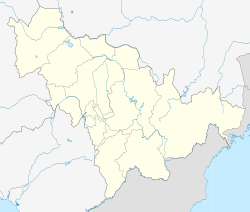Jilin Provincial Museum
 From Wikipedia - Reading time: 6 min
From Wikipedia - Reading time: 6 min
吉林省博物院 | |
 Jilin Provincial Museum | |
| Established | 14 February 2004 |
|---|---|
| Location | Nanguan District, Changchun, Jilin, China |
| Coordinates | 43°46′06″N 125°26′00″E / 43.768461°N 125.433237°E |
| Type | Provincial museum |
| Key holdings | Cultural relics from Buyeo, Balhae, and Goguryeo; the Zhang Boju and Pan Su art collection |
| Collection size | approx. 120,000 objects |
| President | Li Gang (李刚) |
| Website | jlmuseum |
| Floor area | 32,000 m2 (340,000 sq ft) |
| Previous names | Jílín shěng bówùguǎn 吉林省博物馆[1] |
The Jilin Provincial Museum (simplified Chinese: 吉林省博物院; traditional Chinese: 吉林省博物院; pinyin: Jílín shěng bówùyuàn) is a first-grade museum in Changchun, Jilin province, China, dedicated to history and art.[1] It is a subordinate unit of the Jilin Province Department of Culture and Tourism.[2]
History
[edit]The Jilin Provincial Museum was founded in 1951 and formally opened in Jilin City in 1952. In 1954, the provincial government seat was moved to Changchun, and the Jilin Provincial Museum followed it.[2] In 2012, the museum was listed as a national first-grade museum.[3] After nine years of construction,[4] the museum moved to its present location on Yongshun Road (Chinese: 永顺路; pinyin: Yǒngshùn lù), Nanguan District, in 2016.[2]
Collection
[edit]Artefacts from the Goguryeo and Balhae kingdoms, as well as the Khitan Liao and Jurchen dynasties, make up a large proportion of the museum's collection. In addition, the museum has a large number of calligraphic art pieces from various historical periods, including the modern era, and cultural relics from the Northeast Anti-Japanese United Army.[2]
Some of the museum's art pieces include:[2]
- Two scrolls painted by the Northern Song poet Su Shi
- 'Hundred Flower Painting' (Chinese: 百花图; pinyin: Bǎihuā tú) by the Southern Song painter Yang Jieyu (杨婕妤)[5]
- 'Wenji returns to Han' by the Jurchen dynasty painter Jin Zhangyu (金张瑀)
- 'Lin Li Gonglin's Nine Songs' by the Yuan dynasty painter Zhang Wo
Some of the museums artefacts include:[2]
- The 'Bing Wu Shen Gou' (丙午神钩), a silver belt hook with gold gilding from Buyeo[4]
- Bronze mirrors with Khitan script
- A painted, stone-cut Khitan pagoda
- Murals from the Khitan Kulun tombs
Exhibitions
[edit]There are a number of permanent, temporary,[6] and digital[7] exhibitions at the museum.
A collaborative exhibition between Jilin Provincial Museum and the Northeast Anti-Japanese United Army Memorial Hall[8] called 'Souls of the Black Earth Army: Military History of the North-east Anti-Japanese United Army'[9] was awarded a National Museums' 10 Great Exhibitions excellence award (2012–2013).[10] The exhibition was designed to assist in developing a patriotic education.[11]
Gallery
[edit]- Artefacts
-
Bronze Age ceramic cup with handle from Da'anhanshu
-
The 'Bing Wu Shen Gou', a bronze belt hook from Buyeo with silver and gold gilding
- Art collection
-
Peonies and Daffodils by the Qing dynasty artist Wu Changshuo
References
[edit]- ^ a b 吉林省博物院简介 [Introduction to Jilin Provincial Museum] (in Chinese). Archived from the original on 18 February 2020. Retrieved 12 May 2020.
- ^ a b c d e f 吉林省博物院 [Jilin Provincial Museum] (in Chinese). Jilin Province Department of Culture and Tourism. 16 November 2005. Retrieved 12 May 2020.
- ^ State Administration of Cultural Heritage (7 December 2012). 关于发布第二批国家一级博物馆名单的通知——文物博函〔2012〕2237号 [Notice on the announcement of the second national first-grade museums of China list: cultural relics case (2012) number 2237] (in Chinese). Central People's Government of the People's Republic of China. Retrieved 12 May 2020.
- ^ a b Wang, Zhen (29 September 2016). "Seven highlights from the new Jilin provincial museum". China Daily. Retrieved 12 May 2020.
- ^ Pei, Shuyan; Yang, Shuangrong (2019). "Collectors and Museum Construction in Modern China". 2nd International Conference on Contemporary Education, Social Sciences and Ecological Studies (CESSES 2019). Atlantis Press. pp. 713–715. doi:10.2991/cesses-19.2019.160. ISBN 978-94-6252-816-1. ISSN 2352-5398. S2CID 209784209.
- ^ 陈列展览 [Exhibitions] (in Chinese). Jilin Provincial Museum. Archived from the original on 18 February 2020. Retrieved 12 May 2020.
- ^ 数字展馆 [Digital exhibitions] (in Chinese). Jilin Provincial Museum. Retrieved 12 May 2020.[permanent dead link]
- ^ simplified Chinese: 东北抗日联军纪念馆; traditional Chinese: 東北抗日聯軍紀念館; pinyin: Dōngběi kàngrì liánjūn jìniànguǎn
- ^ simplified Chinese: 黑土军魂——东北抗日联军军史陈列; traditional Chinese: 黑土軍魂——東北抗日聯軍軍史陳列; pinyin: Hēitǔ jūn hún——dōngběi kàngrì liánjūn jūnshǐ chénliè
- ^ simplified Chinese: 全国博物馆十大陈列展览精品奖; traditional Chinese: 全國博物館十大陳列展覽精品獎; pinyin: Quánguó bówùguǎn shí dà chénliè zhǎnlǎn jīngpǐn jiǎng
- ^ Liu 刘, Hui 辉 (2013). 春草集(二)——吉林省博物馆协会第二届学术研讨会论文集 [An overview of features of the exhibition "Souls of the Black Earth Army: Military History of the North-east Anti-Japanese United Army"]. 浅谈《黑土军魂》——东北抗日联军军史陈列的特色. Second Academic Discussion Forum of the Jilin Province Museum Association (in Chinese). Vol. 2. Changchun. pp. 6–10.
 KSF
KSF


